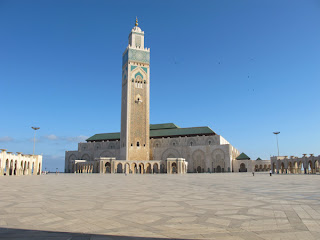Moving On . . .
 The second day of this trip took us to a number of places. First, we visited Hassan II Mosque in Casablanca. It's the largest mosque in Morocco, and the second largest (after Mecca) in the world. It's also one of the few mosques in Morocco that non-Muslims can enter (this has to do with old laws put in place when Morocco was still a French Protectorate).
The second day of this trip took us to a number of places. First, we visited Hassan II Mosque in Casablanca. It's the largest mosque in Morocco, and the second largest (after Mecca) in the world. It's also one of the few mosques in Morocco that non-Muslims can enter (this has to do with old laws put in place when Morocco was still a French Protectorate).
This is an ablution room. It is below what Christians would call the sanctuary, and we could see it from the mosque through star-shaped plexiglass cutouts in the floor. There are rituals surrounding washing before praying, and this is where the men come to do that.

There is also a hammam (like a Turkish bath) in the mosque, and I think this is the one is where women can come.

As a matter of respect, our guide asked us to wear scarves and long sleeves when we visited the mosque. This is me toward the end of the mosque tour - my yellow pashmina (100% Kashmir if you're following the fiber ;-D) came in handy for this. We also had to take our shoes off and carry them in a bag when we were actually inside the mosque. One of my fellow travellers, who is Muslim, helped me with the scarf.

Not sure if you can grasp the scope of how huge this mosque is - if you click on the photos they will all biggify and you will be able to see them better. The men pray on the main floor, and the wooden balconies are for the women. The story we were told (more than once) is that women are segregated so that men are not distracted during prayer . . .
 Next, we headed to the Imperial city of Rabat, which is also the capital city of Morocco. We visited the Hassan tower, all that is left of a mosque which was begun in 1196. It would have been huge (30,000 square yards) in its finished state, but it was never finished. And then the Lisbon earthquake of 1755 did great damage - all that is left is the incomplete tower, the foundation pilings and a bit of the walls.
Next, we headed to the Imperial city of Rabat, which is also the capital city of Morocco. We visited the Hassan tower, all that is left of a mosque which was begun in 1196. It would have been huge (30,000 square yards) in its finished state, but it was never finished. And then the Lisbon earthquake of 1755 did great damage - all that is left is the incomplete tower, the foundation pilings and a bit of the walls.One of the interesting things that I learned on t
 his trip is about the mosaic, stucco and plaster decorations that are found everywhere on mosques and other architecture. There are no humans or animals depicted anywhere - no images. All decorations are stars and other shapes, intricate mosaic patterns, and calligraphy. The colors of Islam are blue and green, and all the stucco and plaster ornamentation is hand carved . . . it's pretty amazing stuff.
his trip is about the mosaic, stucco and plaster decorations that are found everywhere on mosques and other architecture. There are no humans or animals depicted anywhere - no images. All decorations are stars and other shapes, intricate mosaic patterns, and calligraphy. The colors of Islam are blue and green, and all the stucco and plaster ornamentation is hand carved . . . it's pretty amazing stuff. We spent part of the afternoon in the Kasbah des Oudaias, and it was very beautiful, and hey, every time I was near the water, I was happy :-)
We spent part of the afternoon in the Kasbah des Oudaias, and it was very beautiful, and hey, every time I was near the water, I was happy :-)
Kind of reminded me a little of the Greek Islands with all the blue and white.
And then, we headed for Meknes . . .
My journal notes for this day say, "women here are non-existent in the day-to-day culture . . . it's interesting . . . and I never see them alone . . . " This is interesting, because our city guide today was a woman and she was very sharp and knowledgeable. She was also dressed in Western attire and had lived in Japan for more than a decade - so, not the typical Moroccan woman at all.
I have finished my photobook - there is a link to it, over on the right. A lot of the photos I'm including in these posts are not in the book, in case you were wondering :-) I took a LOT of photos and am happy to have this space to share even more of them.
Comments
Judaism is the same way. The men and the women are separated so as not to distract while praying.